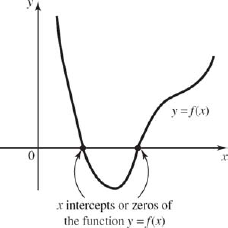5.5. Solving an Equation Graphically
▪ Exploration: Try this.
Solve the equation x2 − 1 = 0. What roots do you get?
Graph the equation y = x2 − 1 for values of x from −3 to +3. What do you observe? Can you draw a tentative conclusion from your findings from steps (a) and (b)?
We can use our knowledge of graphing functions to solve equations of the form f(x) = 0. We mentioned earlier that a point at which a graph of a function y = f(x) crosses or touches the x axis is called an x intercept.
In Fig. 5-26 there are two zeros, since there are two x values for which y = 0, and hence f(x) = 0. Those x values for which f(x) = 0 are called zeros, roots or solutions to the equation f(x) = 0.
Thus if we were to graph the function y = f(x) any value of x at which y is equal to zero would be a solution to f(x) = 0. So to solve an equation graphically, we simply put it into the form f(x) = 0 and then graph the function y = f(x). Each x intercept is then an approximate solution to the equation.
Figure 5.26. FIGURE 5-26

Example 22:Graphically find the approximate root(s) of the equation
Solution: Let us represent the left side of the given equation by f(x).
Any value of x for which f(x) = 0 will be a solution to Equation (1), so we f(x) simply graph and look for the x intercepts. The graph can be made manually as was shown ... |
Get Technical Mathematics, Sixth Edition now with the O’Reilly learning platform.
O’Reilly members experience books, live events, courses curated by job role, and more from O’Reilly and nearly 200 top publishers.

